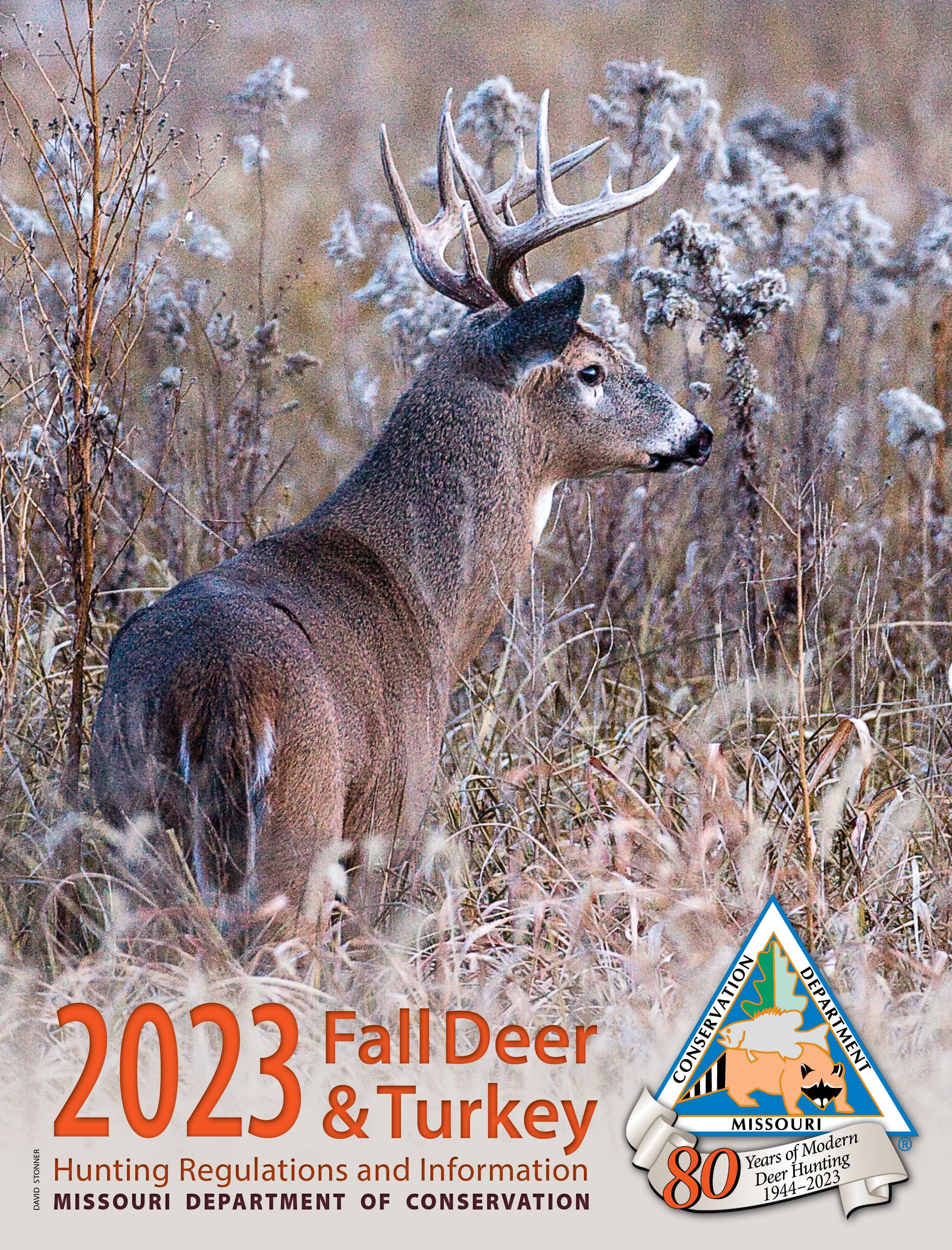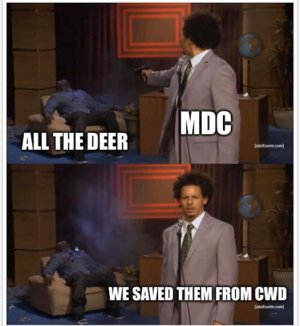bravo, you are desperately trying to reach. I post info and others can form their own opinions from it.
In 2017 and 2018 the Association of Fish and Wildlife Agencies wrote, "Best Management Practices."
111 pages. There is no science in it. To date they do not know how CWD moves about.
In 2019 they did a First Supplement. 22 pages. Am not going to cut and paste them all just the pages pertinent:
https://www.fishwildlife.org/applic.../8052/AFWA_CWD_BMP_First_Supplement_FINAL.pdf
AFWA Best Management Practices for Prevention, Surveillance, and Management of Chronic Wasting Disease: First Supplement A Report of the Association of Fish and Wildlife Agencies Report Editors: Colin Gillin, Oregon Department of Fish and Wildlife, and Jonathan Mawdsley, Association of Fish and Wildlife Agencies
Contributors and Reviewers:
Charlie Bahnson, North Dakota Game and Fish Department
Johnathan Bordelon, Louisiana Department of Wildlife and Fisheries
Chris Cook, Alabama Department of Conservation and Natural Resources
Merril Cook, North Carolina Wildlife Resources Commission
Doug Cottam, Oregon Department of Fish and Wildlife
Mark Cunningham, Florida Fish and Wildlife Conservation Commission
Scott Durham, Louisiana Department of Wildlife and Fisheries
Matthew Eckert, Colorado Division of Parks and Wildlife
Colin Gillin, Oregon Department of Fish and Wildlife
Daniel Grove, University of Tennessee
Jeremy Hurst, New York State Department of Environmental Conservation
Lane Kisonak, Association of Fish and Wildlife Agencies
Gabriel Jenkins, Kentucky Department of Fish and Wildlife Resources
Anne Justice-Allen, Arizona Game and Fish Department
Jim LaCour, Louisiana Department of Wildlife and Fisheries
Jonathan Mawdsley, Association of Fish and Wildlife Agencies
Brandon Munk, California Department of Fish and Wildlife Members of the North Carolina Chronic Wasting Disease Task Force
Kenny Ribbeck, Louisiana Department of Wildlife and Fisheries
Mark G. Ruder, Southeastern Cooperative Wildlife Disease Study
Sherri Russell, Missouri Department of Conservation
Charles Ruth, South Carolina Department of Natural Resources
Krysten Schuler, Cornell University College of Veterinary Medicine Southeastern Association of Fish and Wildlife Agencies Cervid Working Group
Jonathon Shaw, North Carolina Wildlife Resources Commission
Kelly Straka, Michigan Department of Natural Resources
Jeb Williams, North Dakota Game and Fish Department
Peregrine Wolff, Nevada Department of Wildlife
Mary Wood, Wyoming Game and Fish Department
Chuck Yoest, Tennessee Wildlife Resources Agency
Taxidermy and Meat Processing Best Management Practices Waste parts or tissues from taxidermy or meat processors should not be disposed of where they can be accessed by cervids and scavengers. Develop recommendations and educational materials for taxidermists and meat processors as well as hunters or others that handle or dispose of cervid carcasses or meat by-products. Some states/provinces may have (or want to consider) laws requiring taxidermists and meat processors to use approved waste tissue and carcass disposal protocols.
• Meat processors should process carcasses individually and avoid mixing meat from multiple carcasses into ground meat products. This practice is specifically related to public health concerns including but not limited to CWD. Although CWD-associated prion disease has never been documented in humans, minimizing risk and limiting human exposure to CWD prions by minimizing the mixing of potentially CWD-contaminated carcasses from untested animals is a food safety practice and should be considered a best management practice.
• Meat processors and taxidermists should clean and sanitize equipment
between animals. If present, CWD prions from infected animals could contaminate processing equipment. Preventing contamination of uninfected carcasses through meat processing is important for limiting human exposure. Recommendations for proper cleaning of equipment can be found in Chapter 15- Recommended Decontamination and Disinfection Methods for Equipment of this document (Gillin and Mawdsley 2018). And though this practice will add inconvenience, time, and expense, this may be considered a best practice.
• Minimize the handling of higher risk tissues from potentially infected cervid carcasses (e.g. brain, eyes, spinal cord, lymphatic tissues, etc.) Specific guidelines should be tailored to the practices of taxidermists and meat processors or hunters. Individuals handling carcasses should wear disposable gloves, wash hands before and after handling carcasses and carcass parts, and disinfect equipment that may have been contaminated. [see Chapter 15 on Recommended Decontamination and Disinfection Methods for Equipment (Gillin and Mawdsley 2018)
• Develop regulations, policy, or administrative rule promoting acceptable waste disposal practices for hunting-based businesses such as taxidermists and meat processors. Provide policy or administrative rule for meat processors and taxidermists to regulate transport, handling, and/or disposition of tissue waste from cervids. This guidance may be generic to include states or provinces where CWD has not been detected in tested animals. Provide regulatory direction for the types of carcass waste allowed into rendering or other disposal facilities using methods specific for waste from CWD endemic areas. Rendering and landfill facilities are often regulated through other agencies (State Department of Agriculture, county government, etc.) requiring coordinated policy/regulation development.
• Request that taxidermists take part in programs that provide heads or samples to wildlife agencies for CWD surveillance including samples from older-age class males and captive cervid facilities. Some states developed a cash incentive program for the collection of samples, while other states have developed training programs for taxidermists willing to collect samples.
• State/Provincial wildlife agencies should provide information regarding instate/province taxidermists and meat processors to hunters to reduce the potential for transportation of potentially infected carcasses or parts. Wildlife agencies should promote the use of local taxidermy and meat processing services in the area the animal was harvested, prior to movement of the carcass out of the area.
• Prohibit or specifically regulate taxidermy or meat processing businesses from having captive cervids (farmed, exhibit, or rehabbed animals) susceptible to CWD infection on the same premises at the business to limit exposure of live cervids to potentially contaminated tissues or environments.
• Prohibit feeding of taxidermy or meat processor cervid waste tissues or scraps to pets, livestock, zoo animals, or wildlife. Alternative strategies supporting these Management Practices include:
• Require permitting/license registration by administrative rule or statute for taxidermy and meat processing as regulated industries. As part of permitting/licensing of taxidermists and meat processors, require reporting of client and carcass harvest location when a CWD sample has been collected.
NDA readers, bravo laments hunting is going downhill. Look at who wrote this emboldened at the top. Taxidermists say business is way down and meat processors are going to be few and far between in the future not wanting to participate in these over regulations. Everyone complains about burdensome regulations and how did it get this way? You are looking at it.


